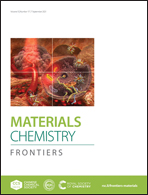In/ZnO@C hollow nanocubes for efficient electrochemical reduction of CO2 to formate and rechargeable Zn–CO2 batteries†
Abstract
Indium (In)-based materials are considered promising electrocatalysts for CO2 reduction to formic acid, but their performance is usually limited by low current density and poor stability. Here, we describe In/ZnO@C hollow nanocubes (NCs), derived from In(OH)3-doped Zn-MOF (i.e. ZIF-8) solid nanocubes, as high-performance CO2-reduction electrocatalysts. The unique nanocube morphology of Zn-MOF makes it an ideal matrix for dispersing In(OH)3 which can avoid aggregation. The formation of a hollow structure is associated with metallic In formation and CO2/CO gas release, resulting from the carbothermal reduction reaction between In(OH)3 and the carbon matrix. In/ZnO@C NCs exhibit excellent catalytic activity and selectivity for formate production, reaching a partial current density of 23.5 mA cm−2 with a Faradaic efficiency of 90% at −1.2 V vs. RHE in 0.5 M aqueous KHCO3 solutions, which is greatly superior to In-free ZnO@C NCs and simple In nanoparticles. Solar-driven electrochemical CO2/H2O splitting can be realized by coupling the In/ZnO@C cathode with a RuO2 anode, offering a promising route to the storage of renewable energy. As a promising technique for CO2 fixation/utilization and energy conversion/storage, an aqueous rechargeable Zn–CO2 battery with In/ZnO@C as the cathode is also constructed. It can output electrical energy with an open-circuit voltage of 1.35 V and a peak power density of 1.32 mW cm−2 while simultaneously realizing CO2 conversion to formate. The Zn–CO2 battery with In/ZnO@C inspires the development of green energy conversion and storage systems combining eco-efficient CO2 utilization.

- This article is part of the themed collection: FOCUS: Recent progress on electrocatalytic CO2 reduction


 Please wait while we load your content...
Please wait while we load your content...